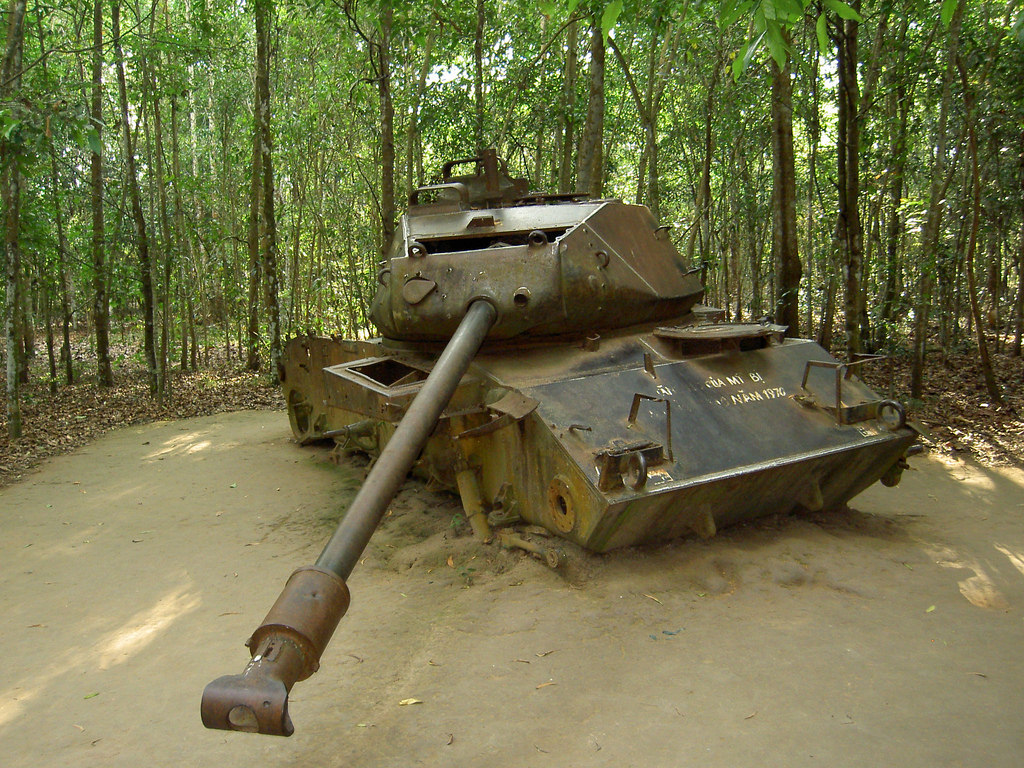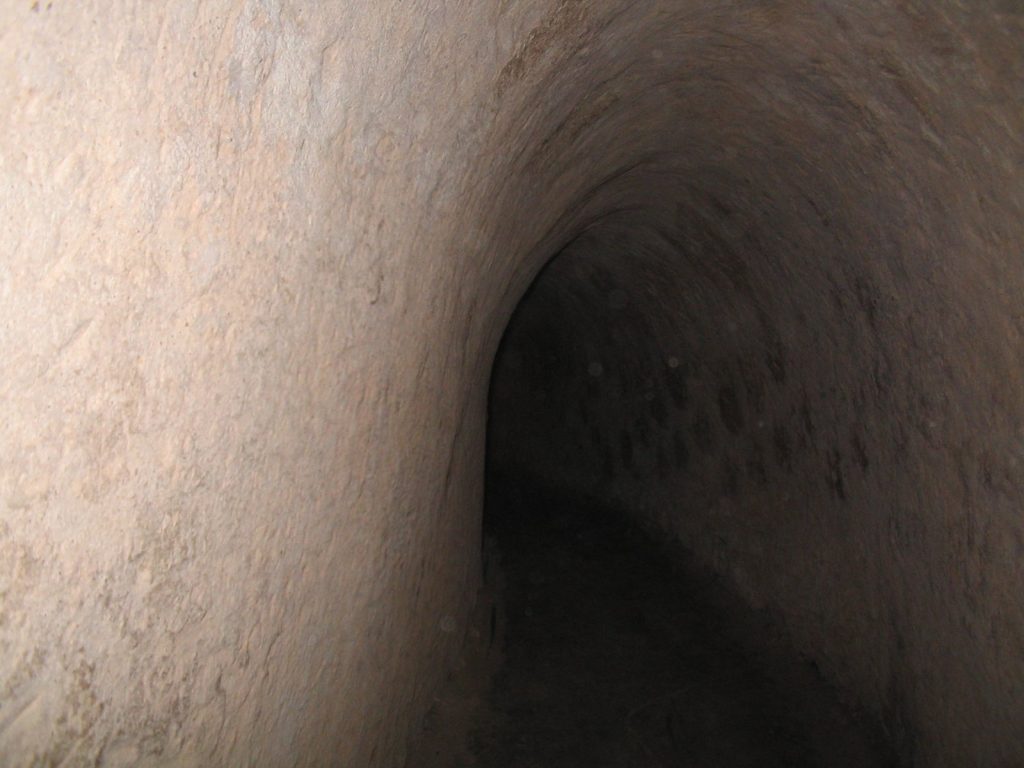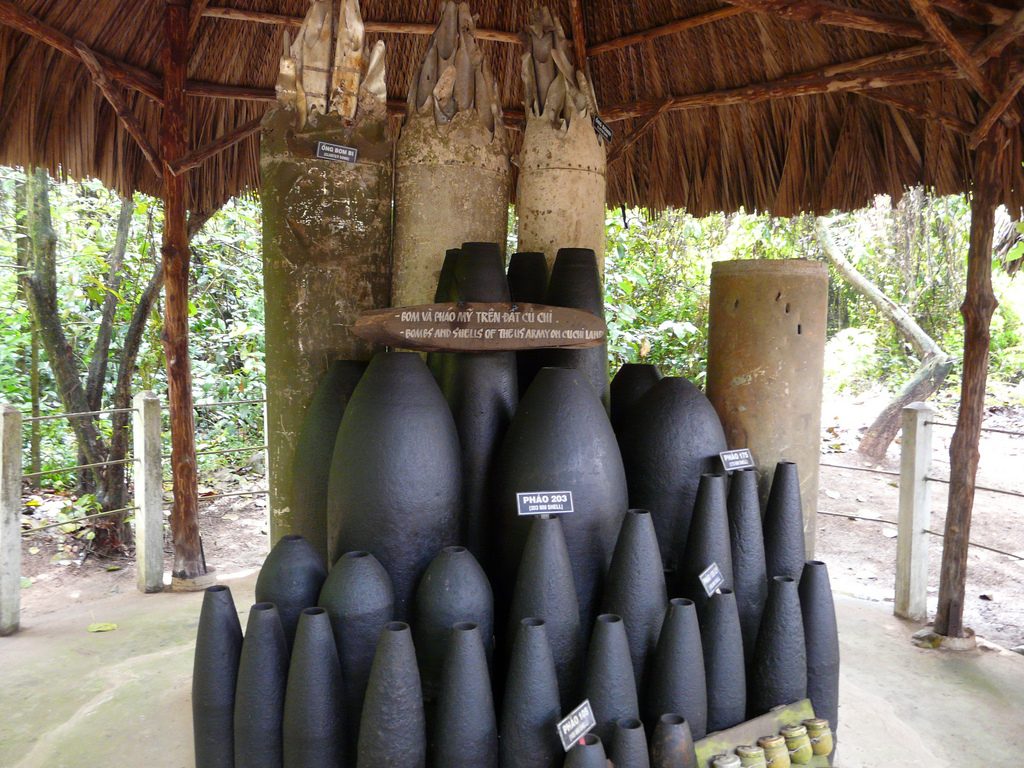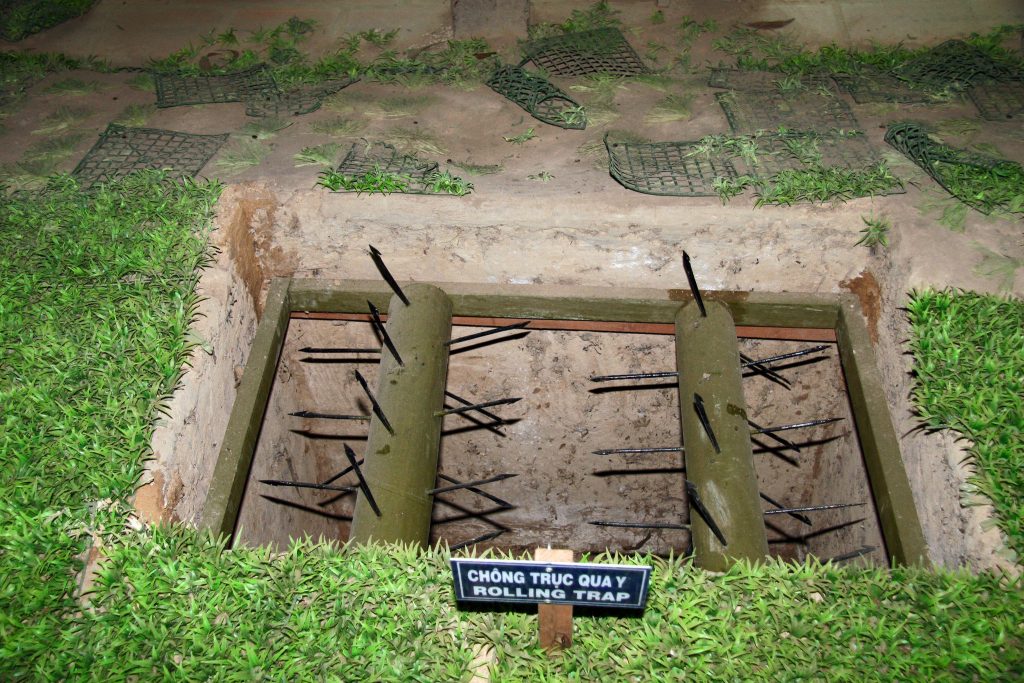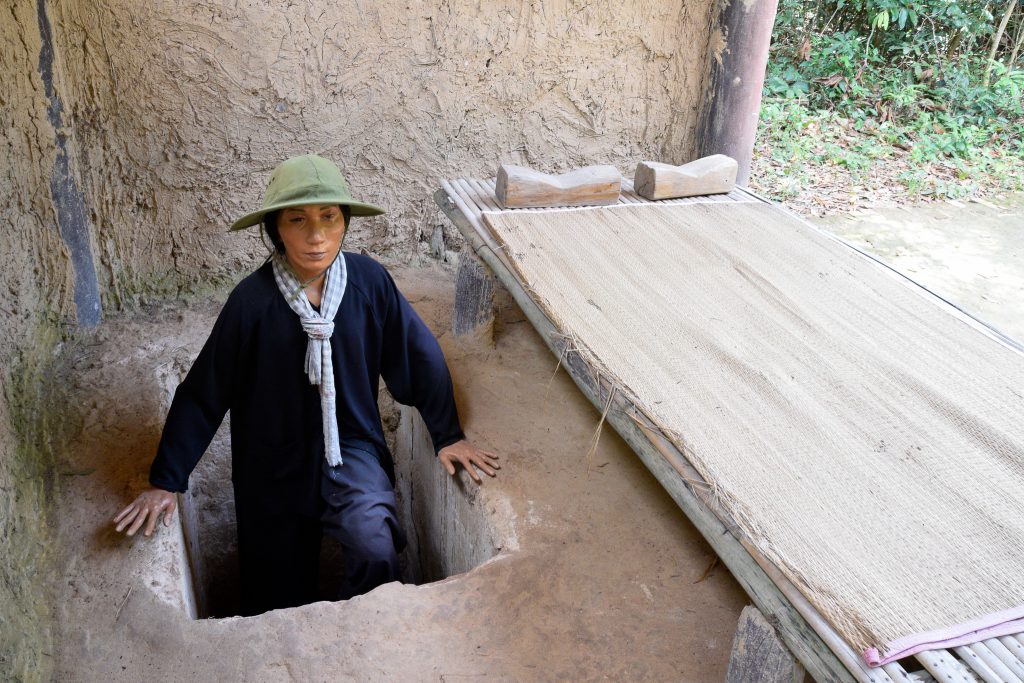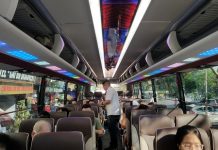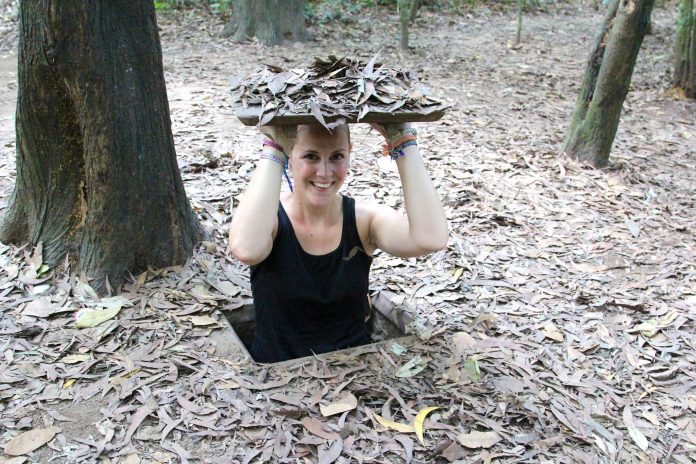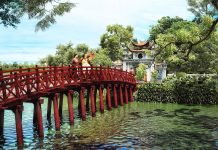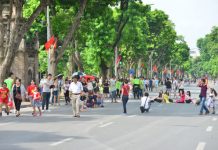Due to conservation of forces to fight in long time, people had to accept all the rigors beyond human endurance. As in the dark, cramped underground, the travel was very difficult, mostly bending or crawling away. Tunnel was wet and stuffy due to lack of oxygen, light (light mainly from candle or flashlight). Whenever a person became fainting, it was necessaty to get out for CPR to regain consciousness. In the rainy season, the ground had more harmful insects, even snakes many where… For women, life was even more difficult. To have a baby and raise the children in the basement tunnels was to suffer so much misery.
Not .only this, hundreds of people up and down the tunnel every day to keep secret tunnels was a very complicated story. A broken grass, soiled land, a torn leaf unusually needed remodeling, otherwise, the enemy could detect and attack.
WAR FROM THE HEART OF THE LAND
Right from the beginning, when the US invaders entered Cu Chi, they had faced fierce resistance of the soldiers and the people here. They were damaged .on the people and war vehicles in the raid to liberated areas. After the suddens, they realized the fighting force coming from under the tunnel, and determined to destroy the tunnel system. Combined with tunnel destruction, destroy the bases to knock away the revolutionary forces, creating a safety belt to protect Saigon headquarters of American – Puppet, also the capital of the puppet government “Republic of Vietnam”.
During a long time, they constantly attacked the raiding bases and tunnel system. Mainly by the following tricks:
1. Use water to destroy the tunnel: In an operation called Crimp (trap), from January 08th to 19th, 1966, the US mobilized 12,000 troops combined with the air force, tanks, newspaper infantry to attack liberated areas north of Cu Chi. The enemy used water pumps into the tunnel, thought that the enemy would be overwhelmed to emerge ground water. When detected hatch in remote places of Saigon River, they used a helicopter hoisting each sitet water to flush into the tunnel. With childish tricks, the enemy could not achieve success as their intention. They could not afford to make the tunnels flooded with too little water, just enough for infiltration into the soil. According to the enemy, they just destroyed 70m tunnel, some too small compared to the tunnel system with hundreds of kilometers. In contrast, during the raid, US forces were hit by soldiers, guerrilla from all sides, day and night, causing 1,600 casualties name, 77 tanks and armored vehicles destroyed, 84 aircraft were shot down. This was a great loss for US forces in military operations “trap”. It proves that people’s guerrilla war was likely to defeat American modern warfare.
Despite the defeat, the enemy continued to attempt to destroy the tunnels. They gave some military experts to directly investigate Cu Chi Tunnel system, but not guaranteed conditions for a thorough investigation, plus the subjective mind, relying .on modern weapons, this brought no results; the next tricks, .once by bine went bankrupt and they got more and more severe loss.
2. Use the “rat” army to attack the tunnel: Cedar Falls In operation, known as “Shelling earth” opening from January 08th, 1967, the enemy mobilized 30,000 troops backed up with tanks, Coins armor, artillery, air force, attacking fiercely into the “iron Triangle”, in which they destroyed towns of Ben Suc (Ben Cat) and severely undermined 6 communes to the north of Cu Chi district underlain in the dense tunnel network.
To perform this big operation, the enemy had the ambition to destroy Command Military Zone of Saigon – Cho Lon – Gia Dinh, the leading body of District Commissioner, destroying the main unit of the Military Zone, destroy the bases and tunnel system, getting the people away, turning the area into a “free zone of destruction”. In fact, the American – the puppet did casualties 1000 people, collecting 15,000 other people in the “strategic hamlets”, burning, breaking 6000 house, stealing 5700 tonnes of rice …
During the raid, the enemy armies using “rat” of 600 infantry soldiers selected the name “little people” in charge of destroying tunnels.
Before opening sweeps, they used “Flying Fortress” B.52 and jets bombs combined with continuous artillery strikes for months, in order to “clear grounds” for landing helicopters and tanks, infantry attack .on the base. They used the napalm which burned hundreds of hectares of forest and gardens. Bulldozers cleaned the woods and put the tree back, pouring the gasoline to burn.
There were 4 “rats” each group, two .on the ground, 2 crawling into the tunnels (which they discovered as the soldiesr had moved to another location) equipped with gas masks, rifles, fast, dagger, oblong iron plant, blowers Sliding Agent, flashlight …. Meet the tunnel junction; they put mine there, putting the wire .onto the ground and “firing” for mine explosion blowing the tunnel.
By this method, the enemy destroyed some short tunnels, but nothing compared to the hundreds of km tunnel interlaced many sections, many corners interconnected with each other.
Infantry tactics used to destroy tunnels fails.
During this raid, the fighting forces and people managed to stay and fight back fiercely, defend the Command, the leaders of the District Commissioner and the majority of the base. Anywhere the enemy wnet, the soldiers from the mounds and trenches fought them in every form, every weapon. At the junction of Ben Duoc (now ruined), .only .one team with nine guerrilla fighters, including .one nurse, had to stay continuously for several days, killing 107 enemy soldiers, shooting their tanks.
Cedar Falls Operation suffered heavy losses double than the Crimp raid and must end sooner than expected (to take .only 19 days). These “cast mines” by Hero To Van Duc were used throughout the battlefield, contributing to destroy hundreds of motor vehicles and helicopters, infantry America, repel evil footsteps of the enemy .
For the Cedar Falls, the enemy lost 3500 people, 130 tanks, armored vehicles, 28 aircrafts. The goal of the US was not achieved, as General A. Nasen confessed partly: “The survey said rights after our troops have withdrawn from the” iron triangle “, the Vietnamese Communists broke into first”. After all, the US must admit bitterly: “… cannot destroy the tunnels because it is not .only very deep, but alos extremely winded, not straight anywhere… inefficient to use sappers … and very hard to find the hatch to down the tunnel … “.
3. Use Becgie dogs raiding the tunnels: In the raid, US forces used guided hunting dog Becgie to detect tunnels. Approximately 3,000 children are mobilized into action Cu, Ben Cat. This breed of West Germany, sniffing the very best and trained “professional” before going to Vietnam.
Using military dog tricks made it difficult and dangerous for the guerrilla army, because the rising steam vents and hatch were easy to find by dogs. At first, guerrillas shot dead dog, as the enemy detection, focused raiding. Later, the soldiers puree mixed with dried chili pepper powder sprinkled .on the vents, but not okay for dogs inhaling pepper coughing caused the enemy to detect tunnels. The work quickly became complex. The units encouraged people to make suggestions to fight against the dogs, finally figured out how to disable the large army dog, the risks and benefits. According to the announcement, in the campaign using dogs in Cu Chi Tunnel, 300 dogs were sick and killed by guerrillas. Thus Becgie dog tricks used to detect the tunnels of the US military went into failure.
4. Use motor vehicle to destroy the tunnels: This was an extremely fierce trick, they mobilized hundreds of tanks and motor vehicles horsepower contact tunnels cut pieces. Anywhere they came, they bkew toxic chemicals into the basement, while using loudspeakers to call for soldiesr. In some rare cases, they exposed the secret bunker .onto the ground without knowing people inside the shelter. At night, the soldiers in the tunnel secretly escaped…
In these days, despite the US military collaboration with the army .onslaught, the revolutionary forces still remained in the tunnel, living and fighting, destroyed much of the enemy’s sources.
Not achieve the desired results, the enemy had to abandon this strategy, because they could not afford to destroy out all the tunnels while the troops and guerrillas were fighting back all day and night.
5. Sowing grass for terrain clearance: The enemy also used many tricks to destroy the tunnels and bases, but notably is the trick of sowing grass terrain clearance.
They used aircraft spraying a strange species, Cu Chi people knew as the “American grass”. This grass grew very fast, just a month achieved high as 2-3 meters, sharp and as bis as the chopstick. The other plants are overwhelmed and could not develop. The grass in the forest made it difficult to travel, combat maneuver, but easy to detect targets from enemy aircraft, to bombardment.
By the dry season, US grass became yellow and dry like straw. Aircraft launchers or bombers, artillery made vivid forest burning, left soil inert, the minefield of guerrillas exploded, burning tunnel… The unit, the agency had no terrain to refuge, left footprints in the ash layer. The enemy tracked to basement door. However, the break trick of sowing grass had the same fate with the tricks mentioned above. Because immortality blue of farms still went ahead, covering the bases. The revolutionary forces still remained in Cu Chi. And from the tunnel system, the soldiers and the people attacked the enemy’s lair in Saigon in the spring of 1968, conquered most of the key objectives of the United States – the puppet as Independence Palace , US Embassy, radio, General Staff, Commander Navy camouflage, Tan Son Nhat airport …
After the offense and uprising in Tet Mau Than, morphology of the battlefield had changed. The enemy out strategy “sweep and hold”, open continuous operations, fiercely counter-attacked and swept Cu Chi’s liberated areas, in order to dislodge the revolutionary forces away, creating safety belts to protect Sai Gon. The tunnel was also trying to create and develop firmly for the forces to approach suburban areas, hold the area, ball up new opportunities to prepare for the liberation of Saigon later.
Until the spring of 1975, several large military groups of Corps 3 and army units, locals gathered here toenter liberate town of Cu Chi and last stronghold of the enemy in Saigon, ending the war against the US, at 11 am .on April 30th, 1975.
WAR AND LOSS
By the Civil War’s extremely various and innovative, over twenty years of fighting tenacity, people and soldiers of Cu Chi hit 4269 small and big attacks, collected 8581 firearms, defeated more than 22,582 enemies (more than 10,000 Americans, 710 arrested), destroyed more than 5168military vehicles (mostly tanks and armored vehicles); shot down and beaten down 256 aircraft (mainly helicopters), sinked 22 ships and boats, and destroyed 270 military posts.
Being titled by the National Liberation Front of South Vietnam: CU CHI LAND OF STEEL AND COPPER WALL.
Being honored twice by the Government of the Socialist Republic of Vietnam with the title: HERO OF THE PEOPLE’S ARMED FORCES.
Up to now, Cu Chi district is honored: 19 Hero communes, 39 People’s Armed Forces Hero, 1277 Vietnamese Heroic Mother, 1800 appointed as valiant, awarded two City Council Medals and more than 500 national and Military Medal, Victory of different grades for the collectives and individuals.
To gain the glory achievement, Cu has suffered great sacrifice: In preliminary statistics, the district has suffered: 50 454 attacks; 10,101 civilians had been killed; 10,000 officers and soldiers who died for the liberation of their homeland; hburned 28,421 roof; 20,000 hectares of fields and deforested …
The war has left serious consequences for Cu Chi, especially the tragic loss of life and poverty in the years after the liberation.
Today, the “white zone” has revived intensely. .on the Tunnel now is the green fields and crowded villages. The sworks for livelihoods are growing round the wounds of war.
Cu Chi is innovativing and going to socialism, with strong agricultural structure, .one of th ekey rice and food regions of Ho Chi Minh City, also the solid military fortress to protect the city in the north-western gateway.
CU CHI TUNNEL: TRADITIONAL DESTINATION OF GENERATION AND RESPECT OF FRIENDS ALL OVER THE WORLD
With the value and victory scale gained with bloodshed, efforts of thousands of soldiers, people, the basement of Cu Chi tunnel was recognized by Ministry of Culture as the National Culture- History Monument.
Cu Chi Tunnel quickly attracts the attention of everyone.Visitors in and outside the country come to visit and learn more and more crowded. Cu Chi Tunnel becomes a traditional destination of Vietnam generation and respect of friends in the world.
From the day of peace, there were tens of thousands of tourist group with millions of all color, race all over the world, who came to visit Cu Chi Tunnel. From the General Secretary of the Communist Party, the Head of State, to politicians, generals, scientists, philosophers, writers, journalists, Veterans … had entered the tunnel with all emotion and admiration for the heroic land. A politician in the German Federal Republic said: “For many years I have suspected the struggle of the people of Vietnam. How can a small and poor country defeat a large and wealthy country like the United States? But coming here, go through the 70 meter tunnel, I was self-answering that question. “
Currently, Cu Chi Tunnel is conserved in two locations:
– Ben Duoc Tunnel (Committee Area basement, Command Ministry of Saigon – Cho Lon – Gia Dinh Military Zone) in Phu Hiep Hamlet, Phu My Hung Commune, Cu Chi District, Ho Chi Minh City, recognized by Ministry of Culture – Information as National Historic Site under with Decision No. 54 / VHQD April 29th, 1979.
– Ben Dinh Tunnel (Cu Chi District Commissioner basement) at Ben Dinh Hamlet, Nhuan Duc Commune, Cu Chi District, Ho Chi Minh City, recognized by Ministry of Culture – Information as National Historic Site in under Decision No. 101/2004 / QD-BVHTT .on December 15th, 2004.
